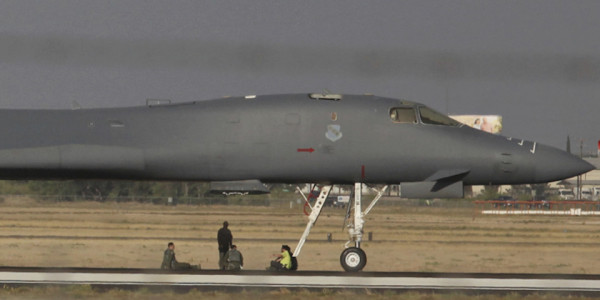

The Air Force has grounded its fleet of B-1B Lancers after an ejection seat reportedly malfunctioned on a crippled bomber last month, forcing the pilots to try to land the plane with a blown emergency hatch after one of the aircrew was unable to eject.
An investigation into the May 1 incident found problems with the B-1B fleet’s ejection seat components, prompting then head of Air Force Global Strike Command to order a safety stand-down for all of the bombers on Thursday, officials said.
“As these issues are resolved, aircraft will return to flight,” the command said in a Friday news release, which did not specify when the B-1Bs might resume flight operations.
The worldwide stand down affects B-1Bs supporting U.S. operations in Iraq, Syria, and Afghanistan, but the Air Force has other aircraft that can take on the bombers’ missions while the aircraft are being inspected, an Air Force official told Task & Purpose on Friday.
Related: That Fiery B-1B Lancer Landing In Texas Was Reportedly A Commander’s Worst Nightmare »
On May 1, a B-1B made an emergency landing in Midland County, Texas, after experiencing an inflight emergency. The unofficial Air Force amn/nco/snco Facebook page reported on May 21 that one of the bomber’s crew had tried to eject after an engine fire but his ejection seats malfunctioned. The mission commander decided to try to land the aircraft rather than abandon the crew member.
Pictures posted on the Facebook page showed one of the bomber’s emergency hatches missing and fire damage to the plane’s right side engines. On Friday, a spokeswoman for Global Strike Command declined to say what the investigation into the incident found or if the ejection seat had failed because a safety investigation board is still looking into what happened.
“However, during the safety investigation process an issue with ejection seat components was discovered that necessitated the fleet-wide stand-down,” Maj. Anastasia Schmidt said in an email to Task & Purpose. “The specific findings and recommendations of the SIB are protected by the military safety privilege and are not subject to release.”

A leaked photo of the engines of the B-1B that had an IFE on May 1st 2018amn/nco/snco FB page
Expected to remain in service until the early 2030s, the B-1B is an critical part of the nation’s conventional arsenal. During the April 13 airstrikes against Syria, Lancers launched cruise missiles at their targets from outside Syrian airspace.
But the B-1 fleet has traditionally had low operational readiness rates. In April 2017, Air Force Times reported that only 25 of the Air Force’s 62 Lancers could fly — less than half of the fleet.
Global Strike Command’s decision to ground all B-1Bs comes after the Air Force ordered a safety stand down for all active-duty units last month in the wake of a spike of crashes. On May 3, a WC-130 from the Puerto Rico Air National Guard went down in Georgia, killing nine airmen.
“The day in itself probably won’t solve the problem,” but it “gives them a chance to identify issues that they can elevate up to the MAJCOM if necessary; that they can raise up to the air staff, if necessary,” Maj. Gen. John Rauch Jr., commander of the Air Force Safety Center, said on May 8.
WATCH NEXT: